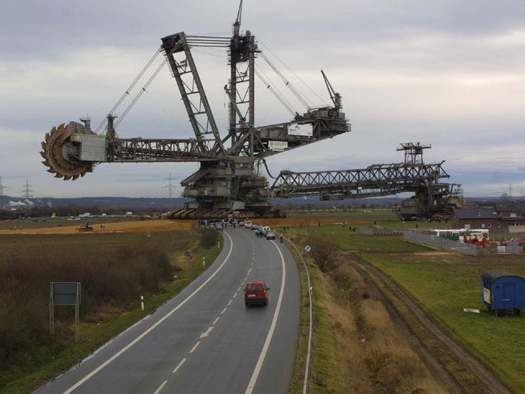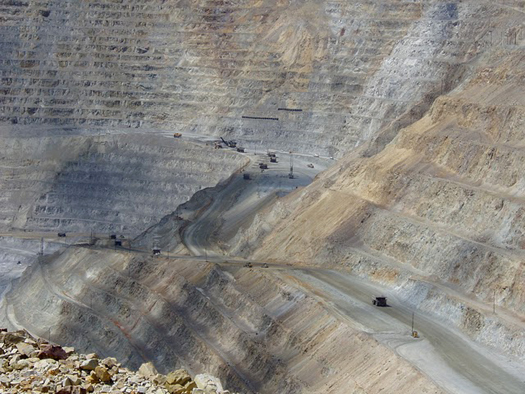
Built in 1978 by German steel company Krupp, the giant Bagger 288 was designed for open mining trenching. It took more than five years and $100 million to design and manufacture. It can move more than 76,000 cubic meters (~2,700,000 cubic ft) of coal, rock, and earth in a day.
Why would anyone need to build such a monster? One reason is that since 1994 mining companies have had to dig up an extra 50 percent of ore to get the same ton of copper. 
According to financier Jeremy Grantham, “copper has an oil-like tendency for the quality of the resource to decline and the cost of production to rise.” Grantham is convinced that the reason copper prices have strengthened since 2010 is that increased global demand has interacted with an industry that is “somewhat challenged to increase copper supply.”
The fact that this 150 percent effort has to be done using energy at two to four times its 1970s price, and the fact that declining ore quality and rising extraction costs are repeated across most important metals, prompted Grantham to predict that the Days of Abundant Resources and Falling Prices Are Over Forever.
Strictly speaking, as John Michael Greer explained recently, we don’t face an energy crisis as fossil fuels and metals run short. What we face is an exergy crisis — a serious shortage of energy and raw materials in highly concentrated forms. That’s a problem, to put it mildly, because nearly every detail of daily life in a modern industrial society depends on using highly concentrated energy sources.
If it is true, as Grantham and Greer insist, that days of abundant resources and falling prices are over forever, then the consequences for many so-called “green technologies” will be devastating.
Copper cables are often used, for example, to allow power generated at solar energy farms and windmill farms to be connected to the electrical transmission grid which uallows this clean electricity to reach our homes. Wind farms, for example, can contain several hundred-thousand feet of copper.
In fact so-called “clean energy” from wind and solar farms require significantly more copper per megawatt of capacity than conventional electricity generation. One industry insider estimated that wind energy is twelve times as copper-intensive as conventional power generation.
In a wind farm, copper is used in the generator to help turn wind power into electrical power, copper cables transport the electricity to where it needs to go, and finally copper is used as an electrical ground to protect wind turbines from lightning strikes.
As for solar farms: they require four to five times more cable than wind farms of equal power generation.
Electric and hybrid cars face the same supply constraints. Conventional automobiles contain 8kg to 33kg of copper (the electrical distribution system/wiring harness accounts for about half of the copper used), hybrid electric cars contain an estimated 33 kg of copper.
New high-speed trains? They are real copper guzzlers. Electric traction engines use from three to four tons of copper — which can be more than double the copper content of traditional electric trains (source: International Copper Study Group.) Additionally, the overhead cables that supply the power to high-speed trains are made of pure copper or a copper alloy. One kilometer of cable uses 10 tons of copper.

Comments [7]
05.31.11
12:09
They are truly impressive and gigantic in scale, particularly when moved across public streets from pit to pit.
The claim however that the demand for them was driven by the cost of copper is false.
In Germany, and particularly this "Bagger" was solely used to mine coal ("Braunkohle" to be precise, which is a softer type of coal that does not lend itslef to traditional mining below grade.
Doesn't take away anything from how impressive they are, .... but the price of copper had nothing to do with it.
06.02.11
02:21
06.04.11
11:30
06.05.11
11:03
I think it would be a good opportunity to highlight the problems that the article suggest in relation to a mere substitution, instead or drastically reducing our consumption of these virgin materials, and also miniaturizing the scale of the overall systems.
Btw, always a pleasure to read your texts.
06.06.11
09:30
06.08.11
09:04
Thank you for following up.
Agreed on both, the environmental impacts of copper mining, and the overwhelming visual impression these excavators have.
Nice piece in any event
06.15.11
01:09